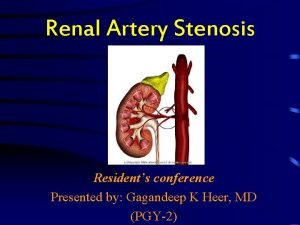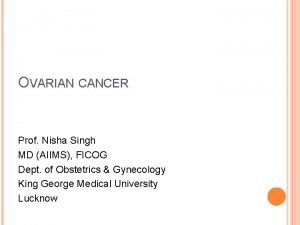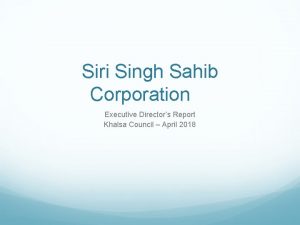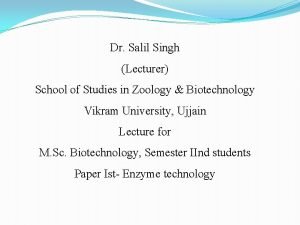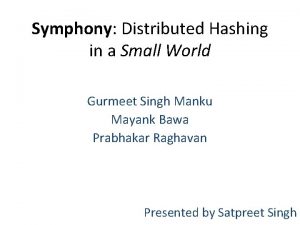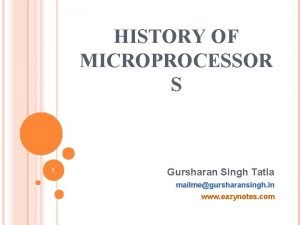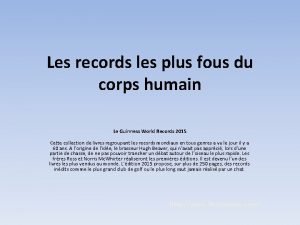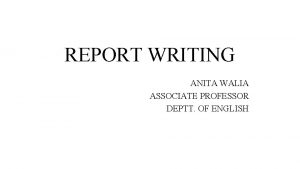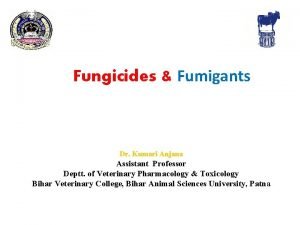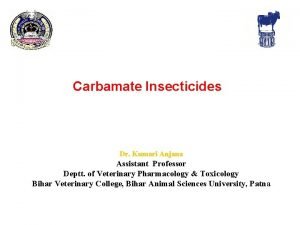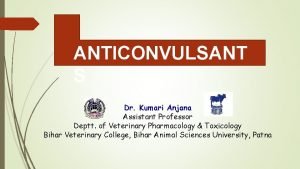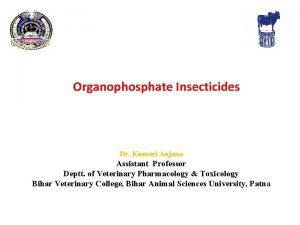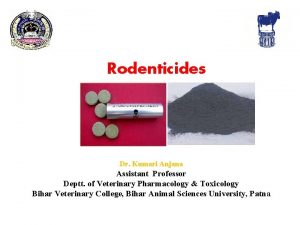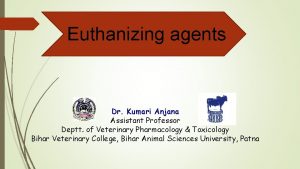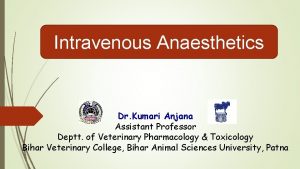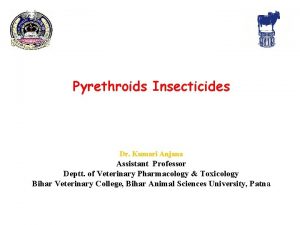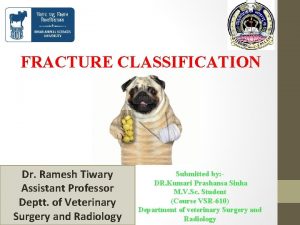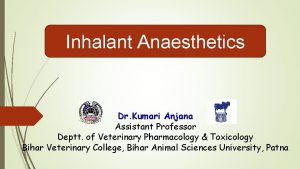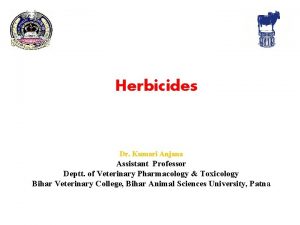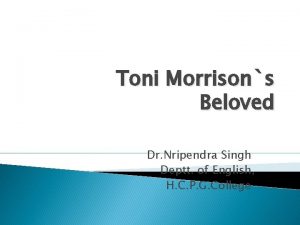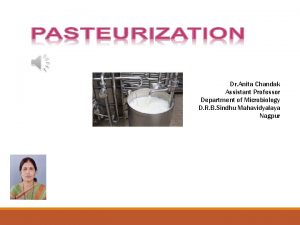Dr Anita Singh Assistant Professor Deptt of Environmental





































- Slides: 37

Dr. Anita Singh Assistant Professor Deptt. of Environmental Sciences

Energy Resources § § § Energy resources are the main sources of energy and can be divided into Fossil fuels (like coal, oil) Nuclear energy Renewable energy (like solar, hydel, wind, biofeul)

Increasing demand for energy § § Transportation Heating Industrial processes Others

India: Import of Crude Oil, Petroleum Products and Total Consumption Source: Petroleum Planning and Analysis Cell, Government of India (Go. I), Gain Report no. IN 5079 dated 07 -01 -2015 Note: Time scale is Indian fiscal year

India: Consumption of Transportation Fuels, in CY Source: Petroleum Planning and Analysis Cell, Government of India (GOI) Gain Report no. IN 5079 dated 07 -01 -2015 *: Estimated for IFY 2016

Source: www. google. com

INDIA’S BIOFUEL POLICY • In the year 2003, the Planning Commission of the Government of India brought out an extensive report on the development of biofuels (Planning Commission, 2003) and bio-ethanol and biodiesel were identified as the principal biofuels to be developed for the nation. • The Go. I approved the National Policy on Biofuels on December 24, 2009.

Continued. . . The current share of biofuels in the consumption of Transportation fuels is extremely low and is confined mainly to 5% blending of ethanol in gasoline which the government had made mandatory in the states of Andhra Pradesh, Goa, Gujarat, Haryana, Karnataka, Maharashtra, Punjab, Tamil Nadu, Uttar Pradesh and Uttaranchal and in the union territories of Daman and Diu, Dadra and Nagar Haveli and Chandigarh. The blending targets for ethanol and biodiesel in gasoline and petroleum diesel, respectively were proposed as 10% and 20% by 2011– 2012 (Planning Commission, 2003) and a 5% ethanol blend in gasoline was made mandatory in 11 states and three union territories of the nation.

Continued. . . • The Go. I approved the National Policy on Biofuels on December 24, 2009. • The policy encourages use of renewable energy resources as alternate fuel to supplement transport fuels and had proposed an indicative target to replace 20 percent of petroleum fuel consumption with biofuels (bioethanol and biodiesel) by end of 12 th Five-Year Plan (2017).

Salient features of India’s biofuel policy • Derive biofuel from non-feed stock that would be grown on degraded soils or wastelands not otherwise suited to agriculture, thus avoiding a possible conflict of fuel versus food security. • Ethanol produced from other non-food feedstock’s besides molasses like cellulosic and lingo- cellulosic materials and including petrochemical route, may be allowed to be procured subject to meeting the relevant Bureau of Indian Standards (BIS) standards (Cabinet Decisions). • (Source: Gain report, 2015)

Bio-ethanol Bio-ethanol is an alcohol made by fermenting the sugar components of plant materials and it is made mostly from sugar and starch crops. But is creates food vs. feed problems. With advanced technology being developed, cellulosic biomass, such as trees, agroindustrial resides and grasses, are also used as feed-stocks for ethanol production. Ethanol can be used as a fuel for vehicles in its pure form, but it is usually used gasoline additives to increase octane and improve vehicles emission. Bio-ethanol is widely used in the USA and Brazil.

Generations of Ethanol production Classification� First generation fuel – from sugar, grain or seeds � Second generation fuel- from lignocellulosic biomass � Third generation fuel- from algal biomass

ADVANTAGES OF BIOETHANOL Ø Ø Ø Ethanol is a much cleaner fuel than petrol (gasoline) Ethanol can be produced from renewable biomass resource Ethanol reduces the need for toxic octane enhancing additives (e. g. MTBE has toxic and carcinogenic properties). Ethanol can be blended into normal gasoline up to 10% without any engine modification Flexible fuel cars can run on any mixture of gasoline and ethanol from ie. 0 to 85 % ethanol.

Continued. . . Ø Ø Ø Ethanol is not a fossil fuel: manufacturing it and burning it does not increase the green house effect A global world contribution to CO 2 saving is of about 4. 5 billion tonn of CO 2 a year (from bioethanol use only) A further significant reduction of noxious pollutants (SOx, NOx, CO, and other toxic polycyclic aromatic hydrocarbon ) in urban areas

Benefits of cellulosic ethanol technology Ø Environmental Little if any net carbon dioxide emission Solid waste disposal Low impact biomass crop Economic Abundant inexpensive, domestic feedstock Low cost potential without subsidies Agricultural and rural manufacturing employment Energy Reduction in oil import and improve energy security Secure resource available for most countries

Ethanol and the Environment EMISSION LOW-LEVEL (E 10) HIGH-LEVEL (E 85) CO 25 -30% DECREASE CO 2 10% DECREASE UP TO 100% DECREASE NOx 5% ↓ UP TO 20% DECREASE VOC’S 7% DECREASE 30% + DECREASE SO 2 AND PARTICULATE MATTER DECREASE (BLENDED WITH DIESEL SIGNIFICANT DECREASE (BLENDED WITH DIESEL) ALDEHYDES 30 -50% INCREASE INSUFFICIENT DATA AROMATICS (BENZENE, BUTADIENE) DECREASE MORE THAN 50% DECREASE

Cellulose based Bio-ethanol production include three steps Pretreatment Enzymatic hydrolysis (saccharification): Cellulases (C 6 H 10 O 5)n + n. H 2 O (Cellulose) C 6 H 12 O 6 (Glucose) Fermentation Microbes C 6 H 12 O 6 (Glucose) 2 C 2 H 5 OH + 2 CO 2

Source: http: //www. bioenergyconsult. com/biochemical-conversion-technologies /

Sources of lignocellulosic biomass §Agricultural crops and residues §Forest residue §Municipal solid waste §Food industry waste

Composition of lignocellulosic biomass • Cellulose • Hemicellulose • Lignin • Other minor components Source: Sun et al. , 2011

Annual crop residue generation in India Source: NIIST-TIFAC survey (Sukumaran et al. , 2010)

Annual surplus availability of crop residues in India Source: NIIST-TIFAC survey (Sukumaran et al. , 2010)

Theoretical Ethanol yield from Potent feedstock (NREL Estimation) Feedstock Theoretical Yield (Liters/dry Tons) Corn Grain 471 Corn Stover 428 Rice Straw 416 Wheat Straw 432 Forest Thinning 309 Hardwood Sawdust 382 Bagasse 422 Mixed Paper 440

Main steps of Bioethanol production process from lignocellulosic biomass • Pretreatment: Physical, Physico-chemical, Chemical and Biological • Hydrolysis: Acid hydrolysis and enzymatic hydrolyis • Fermentation

Pretreatment Physical pretreatment (e. g. Mechanical Comminution, Extrusion) Physico-chemical pretreatment (e. g. Wet oxidation, Microwave alkali) Chemical pretreatment: (e. g. Acid Pretreatment, Alkali pretreatment, organosolv) Biological pretreatment (e. g. Fungi)

Effect of pretreatment on lignocellulosic biomass Source: Volynets and Dahman, 2011

Enzymes involved in Bioconversion process q. Cellulases: to convert cellulose into glucose q. Hemicellulases: to convert hemicellulose into sugars q. Lignolytic enzymes: to convert lignin into soluble fragments i. e. Accessible cellulose. And to convert inhibitors into less toxic compunds


Cellulases q. Cellulases: Endoglucanase, Exoglucanase, bglucosidase §Endocellulases (EC 3. 2. 1. 4) randomly cleave internal bonds at amorphous sites that create new chain ends. §Exocellulases or cellobiohydrolases (EC 3. 2. 1. 91) cleave two to four units from the ends of the exposed chains §Cellobiases (EC 3. 2. 1. 21) or betaglucosidases hydrolyse the exocellulase product into individual monosaccharides

Depiction of enzymatic hydrolysis of cellulose by respective enzymes Source: Volynets and Dahman, 2011

A scheme of some microscale processes that occur during solid-state fermentation (SSF). Source: Holker and Lenz, 2005.

Source: James D. Mc. Millan: Biotecnological routes to biomass conversion

Ethanol yield from different sources (adapted and modified from Mussatto et al. 2010) Source Ethanol yield (L/ha) References Corn stover 912 -2051 Garlock et al. (2009) Wheat 2280 to 2540 Cheryl (2010) Maize 1960 FAO, 2008 Rice 1806 FAO, 2008 Cassava 3, 310 Cheryl (2010); Rajagopal et al. , 2007 Sweet sorghum 3, 050– 4, 070 Lueschen et al. (1991); Hills et al. (1983) Corn 3, 460– 4, 020 Tabak (2009); Rajagopal et al. , 2007 Sugar beet 5, 010– 6, 680 Hills et al. (1983); Brown (2006) Sugarcane 6, 190– 7, 500 Brown (2006) Switch grass 10, 760 Brown (2006)

Commercial status of cellulosic bio-ethanol India has around 330 distilleries which produces 4 billion litres of rectified spirit (alcohol) India produces conventional bioethanol mostly from molasses and partly from grains. The economic , environmental and strategic benefits of cellulosic ethanol could be huge. Production of advanced bioethanol is in its research and development stage.

Ongoing Project UGC Start Up grant project entitled “Cellulase Enzyme Production from Local Thermophilic Fungi by Using Agro-industrial Residues as Substrate” sanctioned vide letter no. No. F. 30111/2015(BSR) dated 30 th March, 2015

References Gain Report no. IN 5079 dated 07 -01 -2015 http: //www. bioenergyconsult. com/biochemical-conversion-technologies Sun et al. (2011) Where are ionic liquid strategies most suited in the pursuit of chemicals and energy from lignocellulosic biomass? Chem. Commun. , 47: 1405 -1421 Sukumaran et al. (2010) Lignocellulosic ethanol in India: Prospects, challenges and feedstock availability. Biores. Technol. , 101: 4826 -4833. Volynets, B. and Dahman, Y. (2011). Assessment of pretreatments and enzymatic hydrolysis of wheat straw as a sugar source for bioprocess industry. Inter. J. Energy Environ. , 2: 427 -446. Holker, U. and Lenz, J. (2005). Solid-state fermentation- are there any biotechnological advantages? Curr. Opin. Microbiol. , 8: 301– 306. James D. Mc. Millan: Biotecnological routes to biomass conversion Mussatto et al. (2010) Technological trends, global market, and challenges of bioethanol production. Biotechnol. Adv. , 28: 817– 830

u o h T Y k n a
 Raj birk
Raj birk Professor anita ghulam ali
Professor anita ghulam ali Cuhk salary scale 2020
Cuhk salary scale 2020 Promotion from assistant to associate professor
Promotion from assistant to associate professor Mh 605
Mh 605 Hypertensive urgency vs emergency
Hypertensive urgency vs emergency Summerpal singh gill
Summerpal singh gill Jyothi singh
Jyothi singh Nisha singh md
Nisha singh md Bhore committee
Bhore committee Iqbal dhaliwal
Iqbal dhaliwal Maan singh sidhu
Maan singh sidhu Daljit nagra wife
Daljit nagra wife Dr nishi singh
Dr nishi singh Dan singh bawa
Dan singh bawa Bro bakht singh birthday
Bro bakht singh birthday Siri singh sahib corporation
Siri singh sahib corporation Sarbpreet singh
Sarbpreet singh Basant kurre ias
Basant kurre ias Salil singh
Salil singh Jarnail singh singapore
Jarnail singh singapore Gursharan singh tatla
Gursharan singh tatla Dr sukhpal singh
Dr sukhpal singh Dr gurbaksh singh
Dr gurbaksh singh Nimi singh
Nimi singh Ca rajiv singh
Ca rajiv singh Basil singh
Basil singh Gurmeet singh manku
Gurmeet singh manku What is singh song about
What is singh song about Ashish singh parihar
Ashish singh parihar Muninder singh
Muninder singh Kartar singh committee
Kartar singh committee Ginette smith
Ginette smith Dr rashmi halker
Dr rashmi halker Dr. vasu singh
Dr. vasu singh Gursharan singh tatla
Gursharan singh tatla Nick stoeberl age
Nick stoeberl age Shrijana singh
Shrijana singh





